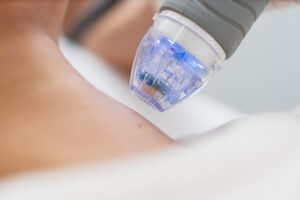 I wrote a blog a little while back about microneedling of surgical scars. The study happened because they thought microneedling would mimic the fractional ablative function of a laser.
I wrote a blog a little while back about microneedling of surgical scars. The study happened because they thought microneedling would mimic the fractional ablative function of a laser.
Lots of studies have been done on microneedling of scars, particularly acne, stretch marks, hypertrophic, or keloid scarring. One metanalysis found 58 studies.
- One benefit to microneedling over laser treatment is for patients with pigmentation in their skin. It is thought microneedling is safer for those with darker skin as the epidermal damage is minimal. Microneedling is a very popular procedure in Asia and the Middle East.
- Animal models show microneedling creates microchannels and micro wounds to the level of the dermis, which breaks up thickened collagen and induces the wound healing cascade.
- Gene expression before and after microneedling shows upregulation of Type I Collagen, glycosaminoglycans, vascular endothelial growth factor, fibroblast growth fact, epidermal growth factor, and transforming growth factor- all which are important for collagen production and new blood vessels.
- Histology shows thickened epidermis and increase dermis collagen and elastic fibers.
- Over weeks to months, new Type III Collagen becomes mature Type I collagen, which causes skin tightening and decreases appearance of scars and wrinkles.
There was a study done where they did microneedling at different times after surgery to see if it helped the scars. They purposefully didn’t do it immediately- they did not want to disrupt the scar during the initial phases- inflammation and proliferation. Their thought was to do it during the maturation and remodeling phases. They found that doing it earlier in that maturation phase was better, with “dramatic differences in final results were revealed”.
- Their study did 3 treatments, spaced one month apart after the first treatment.
- It was plain microneedling (no radiofrequency, no additives through the microchannels created by the microneedling like using exosomes, PRP, or other things) to a depth of 1mm (face) -2.5 mm (body) depending on area.
- All of their patients showed statistically significant improvement from their initial evaluation compared to final evaluation 2 months later.
- NOTE: Almost all scars tend to improve with time.
My thoughts?
I think there is something here. I have done topical liquid silicone and silicone tape for years, but even with being diligent, some form scars which could be better.
Some of scar healing has to do with YOU, the patient. Are you cleaning it daily? removing scabs? making sure it isn’t irritated by clothing, motion, or sun exposure? Are you doing your scar care?
Even if you are perfect, there are genetic differences in healing. Skin pigmentation, your age (yup- we old ladies tend to heal better), location on the body – all these affect scarring too.
I am looking at doing microneedling (likely with exosomes) to scars at 6 weeks for my post surgical patients. I think the studies are showing there is *something* here. But this is still in the fledgling stages. And remember all “microneedling” is not the same. (Doctor office? Sterile? Depth? Timing?)
I think attacking scars which are mature (old acne scars, keloids, and stretch marks) is a harder battle. Getting scars when they are new- red, reactive, weeks and months old- is better likely to make change.
Stay tuned. I will update you as the science and data evolve.
The information provided on this website is for general informational purposes only and does not constitute medical advice, diagnosis, or treatment. Always seek the advice of a qualified healthcare provider for any questions regarding your health or medical condition.
